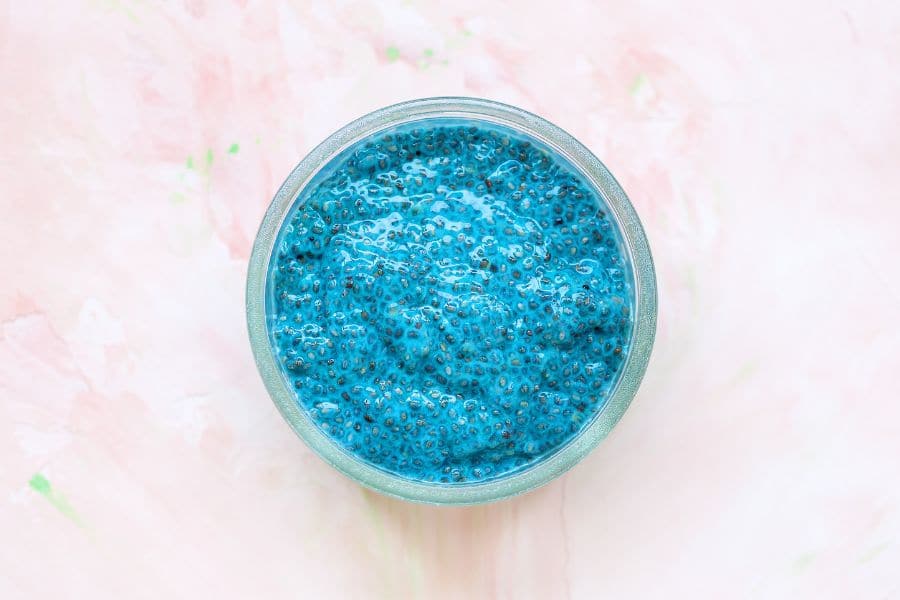*If you buy a product, I’ll make a commission at no extra cost to you!*

You may be wondering, “what is blue spirulina?”.
In case you aren’t aware of this nutritional powerhouse, I’m going to tell you all about the benefits of blue spirulina and what you can expect from the superfood once you’ve purchased it.
How I Started Using Spirulina
Before I start drilling your brain with the laundry list of spirulina-derived benefits. I think it’s important for me to share a bit about my journey with the superfood(so you know I’m a real stan).
I started adding spirulina to my smoothie recipes in the summer of 2016. I was fresh out of high school and the green color of spirulina particularly allured me.
It wasn’t until I discovered blue spirulina that I really started to have fun with the mysterious algae!

I had already been eating a plant-based diet for two years before trying spirulina, so I developed a craving for green leafy vegetables and powders(which made consuming it for the first time even better).
What Is Blue Spirulina?
According to webmd.com, “Spirulina is a blue-green algae, and is believed to be one of the oldest life forms on Earth.”
Spirulina has been around for so long, that Aztecs have reportedly used the algae to boost endurance and stamina during strenuous activities(like long-distance running).
Blue spirulina is extracted from the base algae’s greenish color.
Blue Spirulina Vs Green

There isn’t a nutritional difference between blue and green spirulina(your source is important for potency as well).
I like to think of spirulina as nature’s natural food coloring!
Personally, I like to use blue spirulina to increase the aesthetic of my recipes.
Regular spirulina is usually paired with green leafy vegetables in my smoothies to enhance the nutritional ‘punch’.
If its cool color wasn’t enough, spirulina has even been shown to remove toxic heavy metals from the environment to aid in ecological recovery efforts.
A study on the Bioremediation Of Heavy Metals Using Spirulina found that “Not only the living but the dried and re-hydrated biomass of S. platensis(spirulina) can also be used as a sorbent for
heavy metal removal from water.”
Benefits Of Spirulina For Skin And Hair

Major Nutrients Found In Spirulina INclude…
- Vitamins A, C, B1, B2, & B3
- Anti-inflammatory properties
- May help prevent and fight off cancer cells
- Helps stabilize blood sugar
- Great source of iron, copper, potassium, and even magnesium
Vitamins found in spirulina(especially A and C) are essential for nourishing your skin and hair.
The benefits of spirulina for skin and hair are side perks to the overall nutritional content it provides.
In an article covering the nutritional and therapeutic potential of spirulina, researchers found that, “They are capable to inhibit carcinogenesis due to anti-oxidant properties that protect tissues and also reduce toxicity of liver, kidney and testes.”(1)
Proteins are especially useful for healthy hair growth and skin regeneration.
Thankfully, spirulina is known to be one of the most potent sources of protein per gram!

In an article published by healthplugged.com, it was found that “Pure blue spirulina is an excellent source of protein because it contains roughly 57% of protein and essential amino acids per 100 grams of spirulina — that’s far more than the protein content of red meat or tuna!“(2)
Given my critical nature, it was only right that I scoured scientific journals for more information on spirulina’s benefits.
A study conducted by the University of Pavia found that spirulina contains a hefty amount of protein when measuring the algae’s dry weight.
The article states that “protein represents more than 60% and, in certain samples, even 70% of the dry weight. The protein content of Spirulina appears to be high also when compared with that of unicellular algae and other cyanobacteria.”(3)
How To Use Blue Spirulina

You can use blue spirulina in any way that you’d like! Some of the most common ways to use spirulina include using it in smoothies, juices, and even sauce recipes.
If you’re looking for a delicious blue spirulina recipe, check out my post where I share with you how to make blue moon banana ice cream!
Is Blue Spirulina Vegan?
If you’re wondering if blue spirulina is vegan-friendly, you’ll be delighted to learn that it’s neither plant nor animal!

According to allplants.com, “It’s a cyanobacterium, which is part of a family of single-celled microbes, also called blue-green algae and as cyanobacteria, spirulina is technically neither plant nor animal.”(4)
This stunning fact is what makes blue spirulina completely suitable for vegans and can act as a beneficial supplement for those who need the extra nutrients(which we could all use in today’s society).
One of the best things about Spirulina is that you don’t need to consume a lot of it to reap the benefits. Ingesting one teaspoon of spirulina per day is enough to supply your body with sufficient amounts of vitamins and minerals!
Where To Buy Blue Spirulina
Blue spirulina is harder to find than green. You can purchase organic spirulina by clicking the “buy now” button below!

Citations
Journals.asm.org. (n.d.). Retrieved June 12, 2022, from https://journals.asm.org/doi/pdf/10.1128/mr.50.4.484-524.1986
Khan, Z., Bhadouria, P. and Bisen, P., 2022. Nutritional and Therapeutic Potential of Spirulina. [online] http://www.eurekaselect.com. Available at: <http://www.eurekaselect.com/article/6074> [Accessed 12 June 2022].
Citeseerx.ist.psu.edu. 2022. [online] Available at: <http://citeseerx.ist.psu.edu/viewdoc/download?doi=10.1.1.1050.1238&rep=rep1&type=pdf> [Accessed 13 June 2022].
https://allplants.com/blog/lifestyle/a-vegan-guide-to-spirulina

